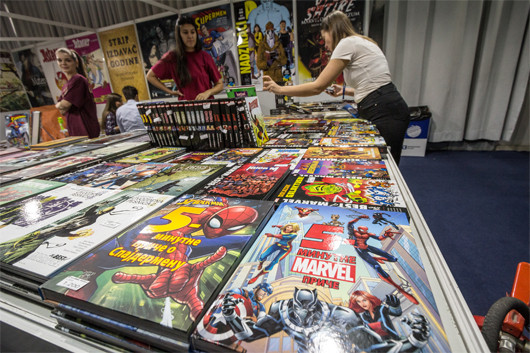Comic Book and Graphic Novel Printing
July 17, 2020
Comic book and graphic novel printing require careful consideration of different printing options. At a minimum, you’ll need to decide the book's dimensions, quantity, page count, ink colors, and paper quality. These affect your success if you want to sell your book online or at conventions.
You’ll want to partner with an established printer with a full range of printing services for comic books. Other printers that specialize in text might not provide vibrant color and perfect binding for a comic printing project.
How Large is Your Comic?
The most used comic book size is 6.625” wide and 10.25” long, and this is the standard used by DC Comics and other major publishers. However, larger magazine-sized comics have become more popular for comic strips in recent years. Smaller manga-size comics are common for graphic novels influenced drawn in Japanese-influenced sequential art styles.
At Comix Well Spring, we also provide custom sizes up to 9” by 12”. We can also print at the 6.5” by 9” size common among graphic novels that achieve widespread acclaim, such as Art Spiegelman’s Maus.
Although there are no strict rules about how big or small your comic book can be, you want to ensure it will fit on the bookshelf. It also helps to consider what genre you're writing in to help determine comic book size, so look at books comparable to yours and see what size they're printed at before deciding.
How Many Comic Books are You Printing?
One of the great benefits of using a printer specializing in comic books is that they're experts in high resolution, low page number projects. If you opt for a traditional bookbinder whose product is textbooks, they may be unable to offer you the options that are more amenable to printing comics.
As a general rule, digital printing is much more useful for projects with fewer books. If you want to print under 400 copies of your comic book, the set-up costs affiliated with digital printing keep costs low and value high.
Offset printing requires more set-up, which costs more. This makes smaller distribution runs less cost-effective. If you want to print 500 to 1,000 copies or more of your graphic novel, consider offset printing.
Number of Pages in Your Comic
To accurately calculate costs, you not only have to figure out how many comic books you need, but how many pages are in each book. This quantity helps your publisher figure out how much paper they will need to print your order.
There's a difference between sheets and pages in the comic book industry: one sheet equals two pages. This means there will always be double the number of pages as sheets in a comic book.
Ink and Paper Options
Most comic books these days are full color printed. However, longer graphic novels are sometimes black and white or grayscale printed on interior pages. All book covers through Comix Wellspring are printed in full color.
We use a variety of paper thicknesses, but generally, for interior pages, 70 to 100 lb., and for an exterior cover, 80 to 130 lb. Please note that interior pages weigh less than cover pages.
Unless otherwise specified on our order form, Comix Well Spring uses 60 lb. uncoated paper for the inside and 80# glossy for the exterior. We also offer matte cardstock for sketch covers, which gives you an exciting way to customize your books for fans. With saddle-stitched books, you can opt for the front cover to be the same thickness as the rest of the pages, referred to as self-cover.
Binding Options
Books bound by saddle stitching are folded over and secured with small metal staples. This type of binding lasts a long time, is cost-effective, and is ideal for comics between 8 and 64 pages long. The amount of sheets needed for a saddle-stitched comic has to be a multiple of four since saddle-stitched books are created from a folded page.
Square binding is the default for longer books and uses glue as the primary binder instead of staples. Sometimes square binding will also use thread, but at Comix Well Spring, we use only glue in a technique called perfect bound books. This creates comic books with a squared-off, flat spine.
The term “graphic novel” usually refers to longer books over 100 pages, and as such, many graphic novel creators stick to square binding. Our square binding can easily accommodate 260 pages, with higher page counts possible in most situations.
Dealing with Margins and Trim
Although our printing technology is exceptionally accurate, tiny differences in page cuts can occur during the printing process. To keep essential images or text from being cut off, we recommend keeping all key visuals and text at least 0.125” inside the trim.
Likewise, full-bleed comic pages should extend the art 0.125” past the trim. This prevents white lines or gaps from appearing when the printer cuts the paper. Comics with white margins or backgrounds do not need this additional extension, but any colored margins should extend 0.125” just like full artwork.

Making Your Comic Shine
Comic books and graphic novels are indeed an art form, and they deserve the best printing possible. Custom printed comic books make your art accessible to comics enthusiasts and give you a way to reach new fans.
At Comix Well Spring, we offer saddle-stitched options for short stories and single issues, and perfect-bound for longer stories. We know the different elements that contribute to your binding choices and are happy to help guide you. Contact our customer service team at (734) 346-7864 with any questions you have throughout the process.

